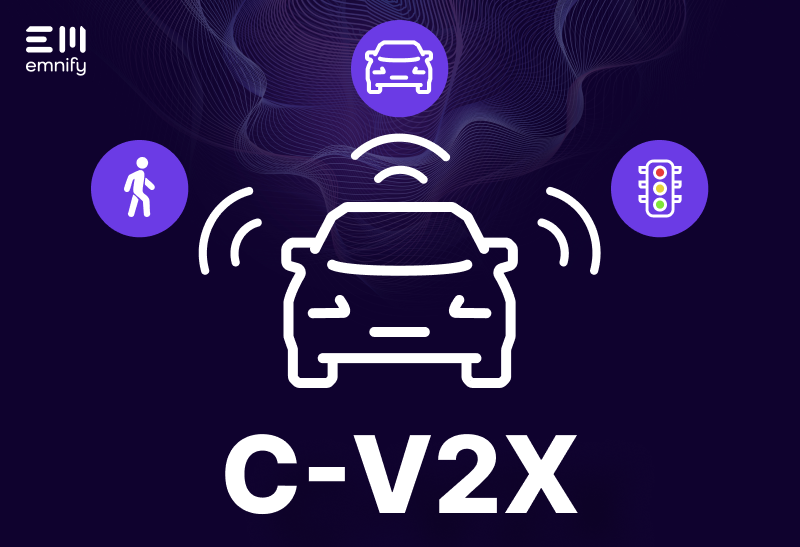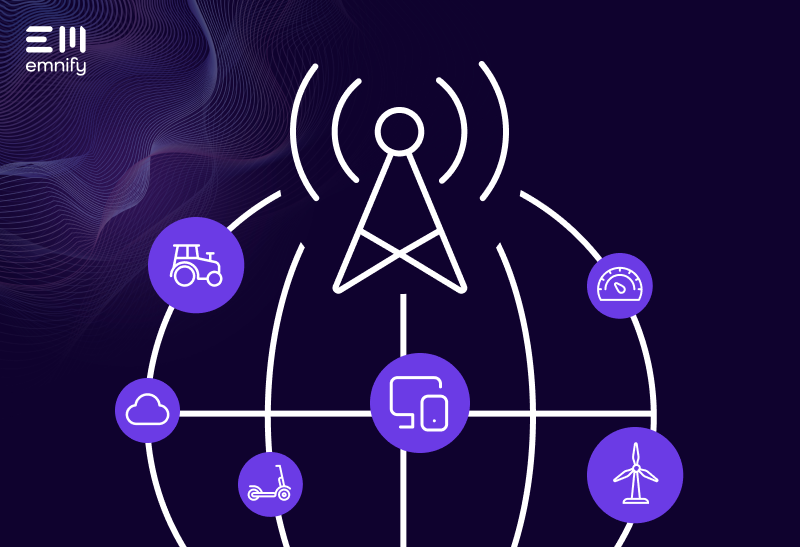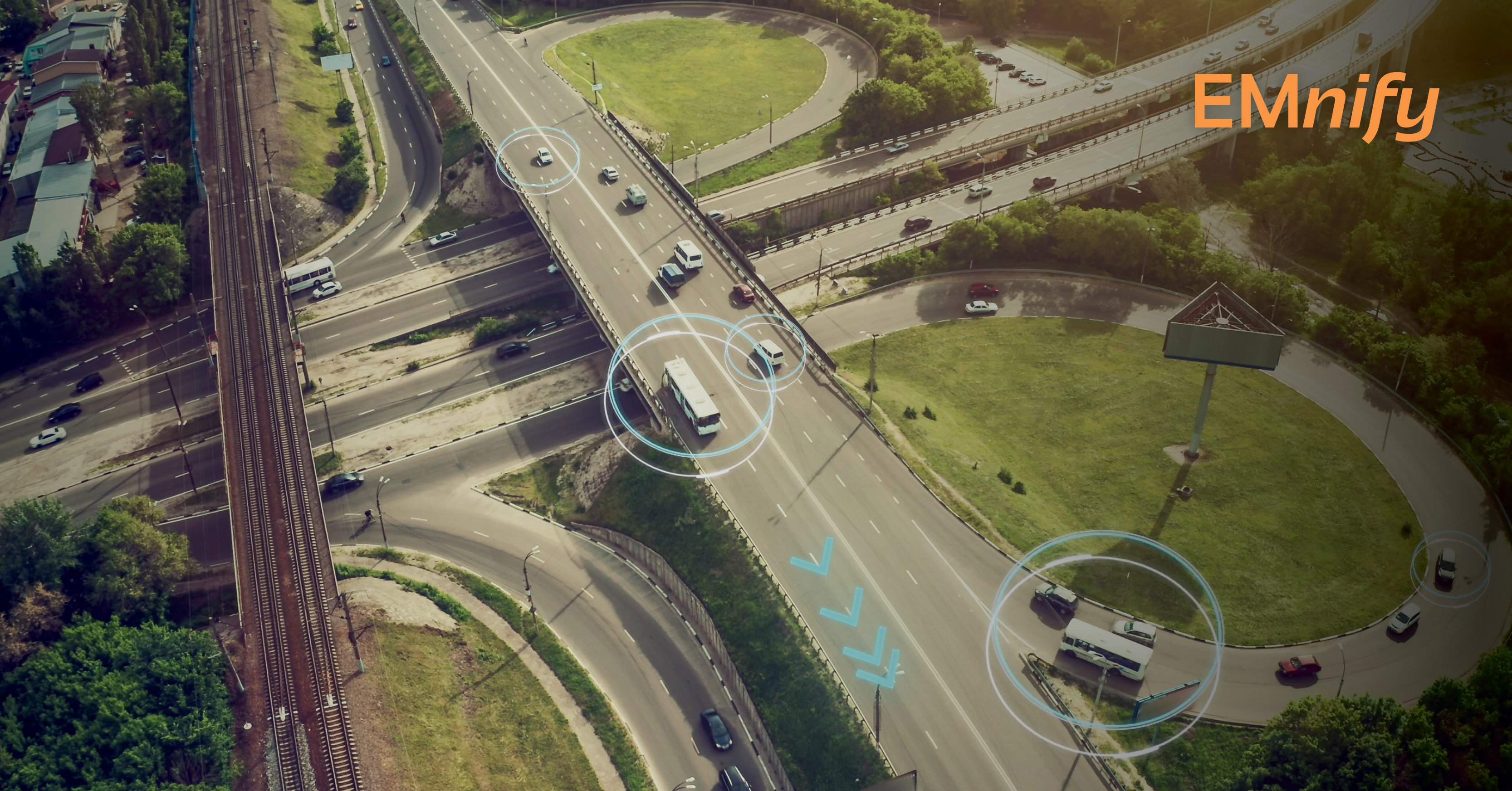

Quick definition: C-V2X stands for cellular vehicle-to-everything. It’s a 3GPP standard that defines cellular technology that enables vehicles to communicate with transportation infrastructure, other vehicles, the cloud, cellular network infrastructure, and even pedestrians. While other technologies help facilitate V2X (vehicle-to-everything), C-V2X specifically refers to the cellular solution.
C-V2X is one of the main ways IoT is being used in transportation. It utilizes cellular IoT to enable vehicles to understand and react to their environment in real time. While perhaps the most obvious application is that it enhances automation in driverless cars, it also improves the information drivers have at their fingertips, particularly when it comes to navigation and visibility, and it can simplify toll and parking systems.
Despite the name, many C-V2X capabilities don’t actually depend on cellular network infrastructure. There are two transmission modes: device-to-network (vehicle-to-network or V2N) and device-to-device, which includes vehicle-to-vehicle (V2V), vehicle-to-road infrastructure (V2I), and vehicle-to-pedestrian (V2P). While V2N uses cellular infrastructure to transmit data through the network and receive information about road conditions and traffic, the other mode uses short-range radio frequencies to enable direct communication between vehicles and nearby devices.
While C-V2X is relatively new, it was designed to replace Dedicated Short-Range Communications (DSRC) and Cooperative Intelligent Transportation Systems (C-ITS), previous standards developed by the Federal Communications Commission (FCC) and the European Telecommunications Standards Institute (ETSI). These earlier standards had dedicated bandwidth and helped facilitate device-to-device communication, but C-V2X offers more advanced functionality.
Let’s look at some of the ways C-V2X is changing modern transportation.
Applications of C-V2X
When vehicles can automatically communicate with nearby devices and cellular networks, it opens the door to numerous possibilities to make transportation safer, smarter, and simpler.
Automated toll collection
Using short-range radio transmissions, vehicles can communicate directly with roadway infrastructure to automate billing or even actual transactions when a vehicle uses a toll lane on the highway or accesses a toll bridge. Instead of relying on cameras to capture photographs of license plates or human toll booth workers to process transactions, the connected vehicle can interact with sensors when they’re within a specific range. Backend technology like blockchain IoT can even use “smart contracts” to approve payments.
This not only saves on operational costs for toll systems, but it also ensures that the toll infrastructure doesn’t disrupt traffic flow or cause delays, and consumers don’t have to worry about watching for a bill in the mail.
Cooperative Adaptive Cruise Control (CACC)
Cooperative Adaptive Cruise Control uses C-V2X to improve on Adaptive Cruise Control (ACC) by leveraging direct vehicle-to-vehicle communication. While ACC alone can use cameras, radar technology, and Light Detection and Ranging (LiDAR) to change speed based on the distance between vehicles, CACC takes additional input from the vehicles themselves. A vehicle equipped with CACC capabilities can adjust cruise control speed to react when the vehicle ahead brakes or the vehicle behind accelerates, creating a safer, tighter feedback loop.
Emergency vehicle prioritization
C-V2X can help emergency responders get to their destinations faster and more safely. Emergency vehicles can use C-V2X to automatically communicate with traffic systems to ensure the first responders have priority for the entire route. These vehicles can also communicate with cellular networks to identify traffic congestion in real-time, helping them avoid routes that might incorrectly appear to be the fastest.
C-V2X can also make it easier for drivers to recognize when emergency vehicles are nearby and need to pass, using standardized onboard warning systems when a nearby vehicle is actively responding to an emergency.
Automated parking payments
Parking is another area where C-V2X can use IoT to streamline the process. In a lot designed for vehicle-to-device communication, each spot can have a sensor that communicates directly with the vehicle to determine how long the vehicle is in a parking spot and what charges are owed. This automated system could either relay billing information, process payment automatically, or use push notifications (potentially with geofencing) to initiate a mobile payment process.
Bring your C-V2X ideas to life with emnify
emnify is a purpose-built cellular IoT connectivity solution used by more than 1,800 businesses around the world. With a single SIM card, your IoT devices can connect to more than 540 networks in over 180 countries. Unlike working a traditional carrier, you’re never locked into a contract, and you’ll only ever pay for the data you use. Our platform also protects your data and devices with multilayered IoT security.
Want to see how it works? Sign up for an trial pack, and we’ll send you two free SIMs with prepaid data plans and two months of complete access to our platform. Get your free SIM cards.
Get in touch with our IoT experts
Discover how emnify can help you grow your business and talk to one of our IoT consultants today!
More than six years of experience as a senior editor in the realm of smart home, connectivity and Internet of Things. And still as curious as on the first day.


